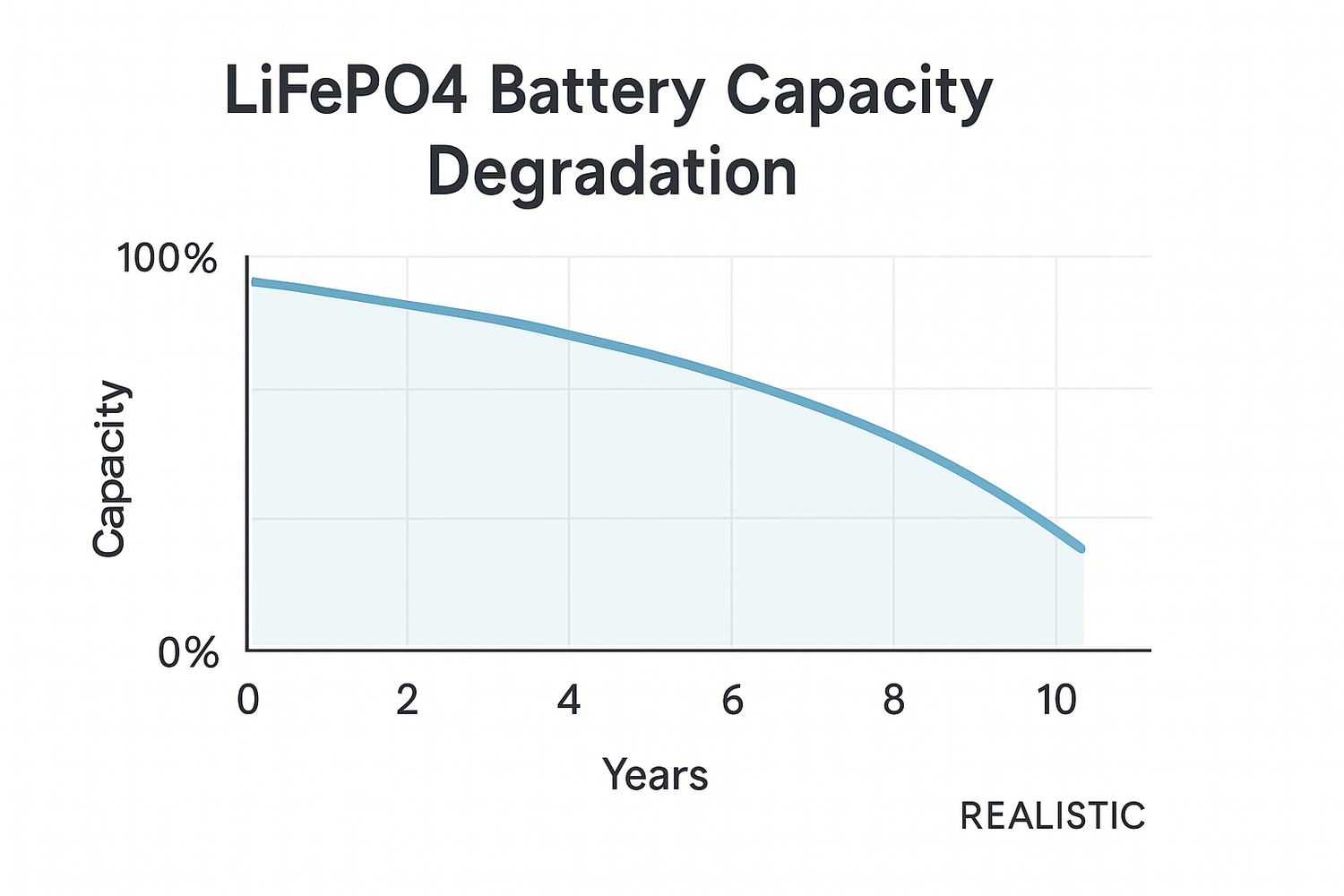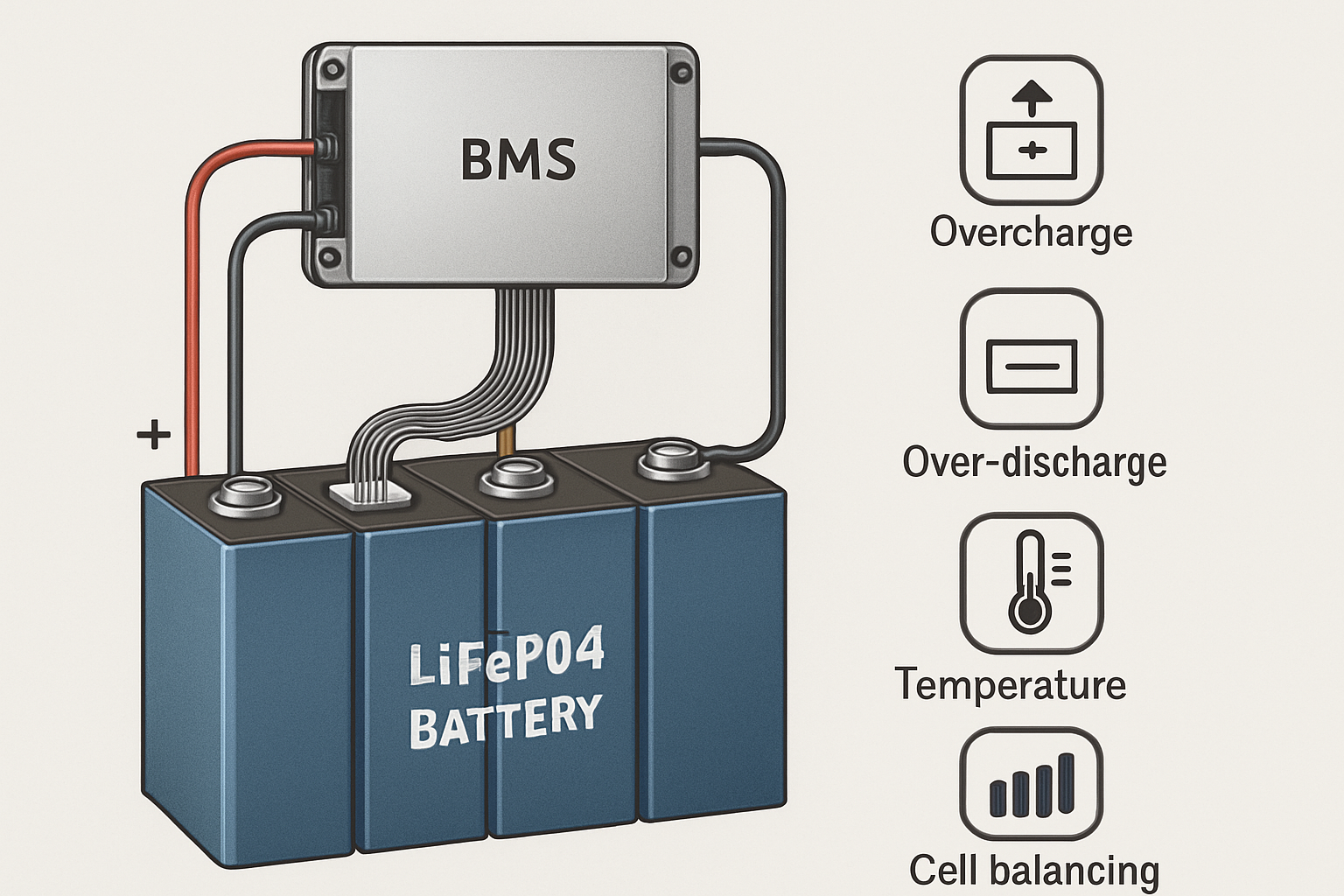Lithium iron phosphate (LiFePO4) batteries are a leading choice for solar energy storage, prized for their safety and longevity. Investing in a solar storage system is a significant commitment, and understanding its realistic lifespan is crucial. This guide provides a practical 10-year outlook on LiFePO4 battery performance, helping you set clear expectations and maximize the value of your energy independence.
Understanding LiFePO4 Longevity: Cycles vs. Calendar Life
A battery's lifespan is measured in two primary ways: its cycle life and its calendar life. Both are critical for forecasting performance over a decade. A high-quality LiFePO4 battery can often deliver 10 or more years of reliable service when properly managed.
What is Cycle Life?
Cycle life is the number of full charge and discharge cycles a battery can complete before its capacity drops to a specific percentage of its original rating, typically 80%. LiFePO4 batteries are known for their impressive cycle life, often rated for 3,000 to 7,000 cycles or more. For a typical solar installation that cycles daily, this easily translates to more than 10 years of operation.
The Importance of Calendar Life
Calendar life refers to the battery's lifespan based on the passage of time, regardless of usage. All batteries degrade slowly due to internal chemical reactions. For LiFePO4 batteries, the stable olivine structure minimizes this degradation, giving them a typical calendar life of 10 to 15 years. This inherent stability is a key reason they are well-suited for long-term applications like solar storage.
How Depth of Discharge (DoD) Dictates Longevity
Depth of Discharge (DoD) is the percentage of the battery's capacity used in a cycle. There is a direct relationship between how deeply you discharge your battery and how many cycles it will last. Consistently using a smaller percentage of the battery's capacity (a shallower DoD) dramatically increases its cycle life. While LiFePO4 batteries can handle deep discharges, avoiding draining them completely is a best practice for extending their lifespan.
| Depth of Discharge (DoD) | Estimated Cycle Life |
|---|---|
| 100% | ~3,000 Cycles |
| 80% | ~5,000 Cycles |
| 50% | ~8,000 Cycles |
| 20% | ~15,000 Cycles |
Key Factors Influencing LiFePO4 Degradation Over a Decade
While LiFePO4 chemistry is robust, several operational factors influence its rate of degradation over the long term. Managing these variables is essential to achieving a 10-year service life.
The Critical Role of Temperature
Temperature is one of the most significant factors affecting battery health. LiFePO4 batteries perform best in a moderate temperature range, typically between 15°C and 25°C (59°F and 77°F). High temperatures accelerate internal chemical reactions, leading to faster capacity loss, while extremely cold temperatures can reduce efficiency and potentially cause damage during charging. Storing the battery in a climate-controlled or well-ventilated area is crucial.
Charge and Discharge Rates (C-Rate)
The C-rate measures how quickly a battery is charged or discharged relative to its capacity. A 1C rate means a full charge or discharge in one hour. While LiFePO4 batteries can handle high C-rates, consistently fast charging and discharging generates excess heat and puts stress on internal components, which can shorten the battery's life. For daily solar use, a lower C-rate of 0.2C to 0.5C is gentler and promotes longevity.
The Function of the Battery Management System (BMS)
A high-quality Battery Management System (BMS) is the brain of your battery pack and is non-negotiable for achieving a long lifespan. It protects the battery cells by preventing overcharging, over-discharging, and operating outside safe temperature limits. It also performs cell balancing, ensuring all cells in the pack are at an equal state of charge. This protective function is fundamental to preventing premature degradation.
A Practical 10-Year Performance Outlook for Your Solar System
Understanding how your battery will perform over its lifespan helps in planning for future energy needs.
Years 1-3: Peak Performance
During the initial years, your LiFePO4 battery will operate at or very near its nameplate capacity. Degradation is minimal, and the system will reliably meet your energy storage needs, assuming it was sized correctly and is operating within its specified limits.
Years 4-7: Gradual Capacity Fade
As the battery accumulates cycles, a gradual and predictable decline in capacity will occur. This is a normal part of the aging process. You may notice that the battery holds slightly less charge than when it was new, but its performance should remain consistent and reliable. Proper management of DoD and temperature during these middle years is key to slowing this fade. You can find more details on tracking these metrics in this ultimate reference for solar storage performance.
Years 8-10 and Beyond: End-of-Life Considerations
Toward the end of its first decade, the battery will likely approach 80% of its original capacity. At this point, it is still fully functional but delivers less energy per cycle. The system will provide shorter backup times or require more frequent support from the grid. Even after its primary life in a solar system, the battery can often be repurposed for less demanding applications before it requires responsible recycling.
Maximizing Your Investment: Best Practices for a Decade of Use
Achieving a 10-year lifespan is not passive; it requires proper system design and operation.
System Sizing and Design
Properly sizing your battery bank from the start is fundamental. An undersized system will be subjected to deep discharges and high C-rates more frequently, accelerating degradation. A well-designed system ensures the battery operates comfortably within its ideal parameters, promoting a long and healthy life.
Environmental Control
Install your battery in a location that is protected from extreme temperatures. A basement, garage, or utility room with stable, moderate temperatures is ideal. Avoid placing it in direct sunlight or in uninsulated spaces that experience wide temperature swings.
Regular Monitoring
Periodically check your system's monitoring software. Pay attention to the battery's state of charge, voltage levels, and temperature. This allows you to spot any potential issues early and ensure the system is operating as intended. According to the International Renewable Energy Agency (IRENA), improvements in battery lifetimes and performance are key to reducing the overall cost of energy storage services. The U.S. Department of Energy also supports research into mitigating battery failure modes to enhance durability.
A Look Ahead: The Future of Long-Lasting Energy Storage
The technology behind LiFePO4 batteries continues to advance, with ongoing research focused on further extending lifespan and improving performance. As the International Energy Agency (IEA) notes, energy storage must increase significantly to support the transition to renewable energy, making battery longevity more important than ever. A well-maintained LiFePO4 battery purchased today is a durable and reliable technology, fully capable of providing a decade or more of clean energy storage and helping you achieve greater energy independence.
Frequently Asked Questions
Will a LiFePO4 battery really last 10 years?
Yes, a quality LiFePO4 battery can last 10 to 15 years in a typical solar application. This longevity depends on proper management, including operating it within the recommended temperature range, avoiding consistently deep discharges (high DoD), and using appropriate charge rates.
What happens to a LiFePO4 battery after 10 years?
After 10 years or thousands of cycles, a LiFePO4 battery's capacity will likely have faded to around 80% of its original state. It is still very usable but will store less energy. At this stage, it can be used for less critical backup power or other low-demand applications before it needs to be recycled.
Is a more expensive LiFePO4 battery with a better BMS worth it?
Absolutely. The Battery Management System (BMS) is crucial for protecting the battery from conditions that cause premature aging, such as overcharging, over-discharging, and cell imbalances. Investing in a battery with a high-quality, advanced BMS is one of the most effective ways to ensure you achieve the maximum possible lifespan from your energy storage system.





Leave a comment
All comments are moderated before being published.
This site is protected by hCaptcha and the hCaptcha Privacy Policy and Terms of Service apply.